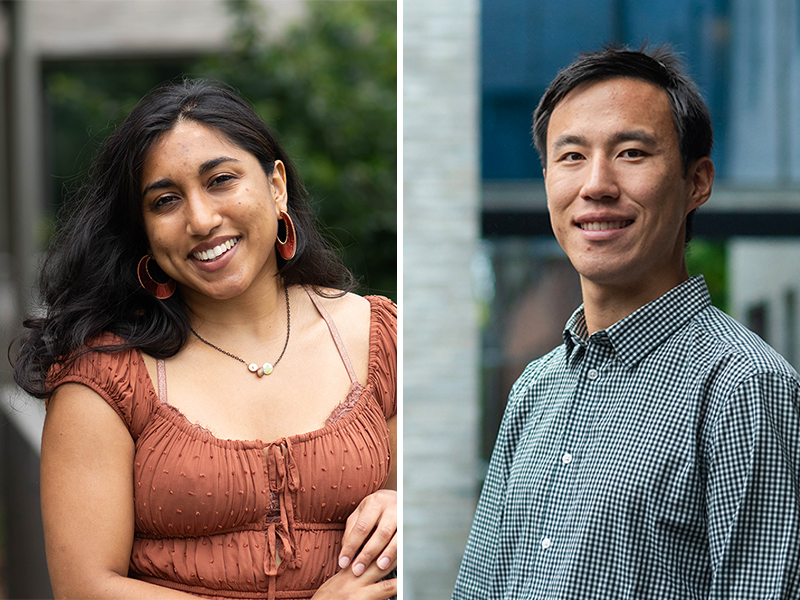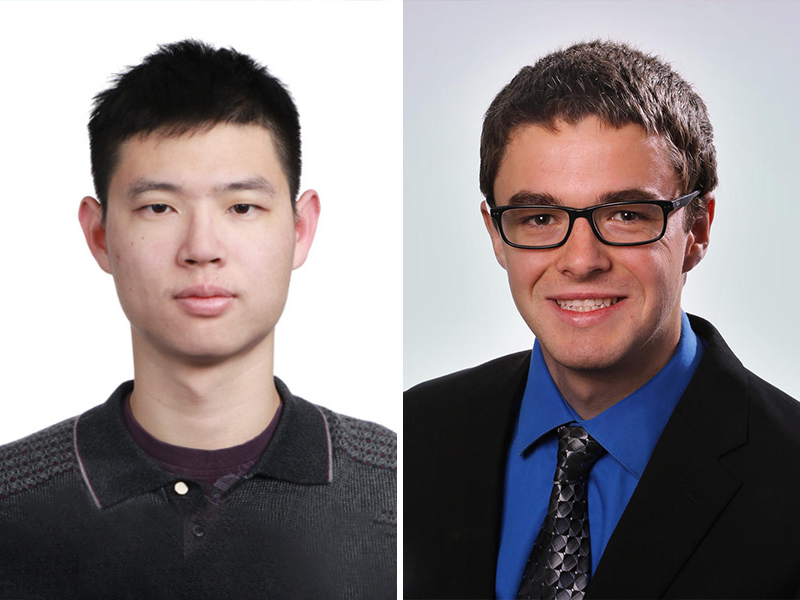New Light: Rising Stars
in Energy and the Environment
2024 SUMMER SEMINAR SERIES
The New Light summer seminar series features the Andlinger Center’s Distinguished Postdoctoral Fellows and early career researchers. There will be three sessions featuring two researchers each: June 24, July 10, and July 16th. Registration is now open.
June 24
-
Beyond Extraction: Modeling and Narratives for Post-Extractive Futures in Appalachia
Abstract: Communities reliant on extractive industries face a paradox in which despite the promise of economic growth from lucrative and well-paying industries, they tend to have poor outcomes in terms of poverty, health, and other socio-economic indicators. In addition, sustainability transitions such as the energy transition will inevitably reshape these communities, which are often the least prepared to adapt to social and economic change. My work takes an interdisciplinary approach drawing on complex systems theory to understand how these communities navigate transitions to fundamentally different economies and livelihoods through 1) a theoretical model linking extraction, institutional capacity, and physical and natural infrastructure to understand when and how these communities undergo abrupt and discontinuous transitions between extractive and non-extractive equilibria, and 2) a case study in current and former coal mining communities in Central Appalachia to understand how Appalachians are envisioning and creating post-coal possibilities within their communities. Insights from both streams of work reveal why it can be so difficult to break out of the “resource curse” or addictive economies of extractive industries without external intervention and how institutional dynamics are critical in producing and perpetuating extractive dynamics in these regions.
Bio: Nusrat Molla is currently a Distinguished Postdoctoral Fellow at the Andlinger Center. She graduated with a B.S. in Civil and Environmental Engineering from UC Berkeley in 2017, and completed her PhD in Land, Air, and Water Resources at UC Davis in 2023. Her work focuses on using dynamical systems modeling, sometimes coupled with empirical qualitative methods, to understand the social and political dynamics of societal transitions in resource extraction and governance.
-
Full-scale flow measurements for wind turbines and the atmosphere
Abstract: Wind energy is scaling up worldwide – in terms of both the number of turbines installed and the size of the turbines themselves, the largest of which are approaching 200 meters in diameter. The interactions of these massive machines with the chaotic motions of the atmosphere occur across a wide range of length scales, which makes them difficult to study using traditional experimental facilities and numerical simulations. This talk will describe three methods that aim to circumvent these complications and provide direct insights into the fluid dynamics of full-scale wind-energy systems and their interactions with the atmosphere. First, we will highlight recent results from a pressurized-air wind tunnel that enables full-scale turbine aerodynamics to be reproduced in the lab. Second, we will describe a field-deployable system that tracks helium-filled soap bubbles to obtain three-dimensional volumetric flow measurements of the atmospheric surface layer. Finally, we will discuss the use of small drones as “smart particles” that are carried passively by the wind and could potentially sample kilometer-scale atmospheric phenomena. These research directions will help improve our understanding of the dynamics of full-scale wind-energy systems and may unlock new possibilities for the enhancement of wind-power generation through real-time sensing, flow control, and optimization.
Bio: Nathan Wei is a postdoctoral fellow at Princeton University’s Andlinger Center for Energy and the Environment and an incoming assistant professor at the University of Pennsylvania in the Department of Mechanical Engineering and Applied Mechanics (starting August 2024). His research combines theoretical, experimental, and numerical approaches to characterize the effects of unsteady fluid mechanics in wind-energy systems and the atmosphere, with a growing interest in field measurements of large-scale flow motions in the atmospheric boundary layer. Nathan graduated summa cum laude from Princeton in 2017, spent a year at the TU Darmstadt on a Fulbright research fellowship, and completed an M.S. in Mechanical Engineering at Stanford and a Ph.D. in Aeronautics at Caltech, working with Prof. John Dabiri. He is the recipient of several fellowships and awards, including a Stanford Graduate Fellowship, National Science Foundation Graduate Research Fellowship, Andlinger Center for Energy and the Environment Distinguished Postdoctoral Fellowship, and three dissertation prizes from Caltech.
-

July 10
-
Coincident Peak Prediction for Capacity and Transmission Charge Reduction
Abstract: Meeting the ever-growing needs of the power grid requires constant infrastructure enhancement. There are two important aspects for a grid’s ability to ensure continuous and reliable electricity delivery to consumers: capacity, the maximum amount the system can handle and transmission, the infrastructure necessary to deliver electricity across the network. These capacity and transmission costs are then allocated to the end-users according to the cost causation principle. These charges are computed based on the customer’s demand on coincident peak (CP) events, time intervals when the system-wide electric load is highest. We tackle the problem of predicting CP events based on actual load and forecast data on the load of different jurisdictions. In particular, we identify two main use cases depending on the availability of a forecast. Our approach generates scenarios and formulates Monte-Carlo estimators for predicting CP-day and exact CP-hour events. Finally, we backtest the prediction performance of strategies with adaptive threshold for the prediction task. This analysis enables us to derive practical implications for load curtailment through Battery Energy Storage System (BESS) solutions.Bio: Zeng is a Ph.D student, advised by Prof. René A. Carmona in the Operations Research and Financial Engineering department. Her research focuses on modeling large-scale stochastic systems through Mean Field Games and on developing numerical methods to solve them. Before joining Princeton, she graduated from Ecole des Ponts in Paris, France, where she obtained a BSc and MRes in applied mathematics and computer science. -
The Oversimplification and Over/Under Estimation of Greenhouse Gas Emissions from the Wastewater Sector
Abstract: Wastewater is a significant source of methane (CH4) and nitrous oxide (N2O) emissions, but the current emission estimations rely on uniform emission factors (EFs) derived from limited studies. To address this limitation, we developed a natural language processing method to extract relevant studies that monitored direct CH4 and N2O emissions from wastewater collection and treatment. Our study expanded the database twelve-fold and the results revealed that plant-wide CH4 and N2O emissions vary by four to six orders of magnitude. Certain biological removal processes exhibited significantly higher emissions than others, and emissions from sludge management and side stream treatment were often overlooked. Despite the rationale for uniform EFs in national GHG inventories, these findings underscore the need for a customized approach to inform national and sector-wide GHG inventories with the emphasis on site-specific considerations. Therefore, we proposed a tier-based approach and applied it to the U.S. water resource recovery facilities (WRRFs). We found that the mean CH4 and N2O emissions from national WRRFs are 10.9 and 11.6 MMT CO2-eq/year, respectively. Adopting such an approach enables more precise estimation by accounting for variations in unit processes and types of biological treatment processes, advancing CH4 and N2O emission management in the wastewater sector.
Bio: Song is currently an Associate Research Scholar in the Department of Civil and Environmental Engineering. Before joining Princeton University in 2021, she earned her Ph.D. in civil and environmental engineering from the University of New Hampshire in 2020. Her research focuses on the sustainability and resilience of critical infrastructures and emerging technologies. She uses interdisciplinary approaches such as big data analysis, computational models, life cycle assessment, and stakeholder engagement to study water-energy-ecosystem-carbon nexus and inform decarbonization pathways.
-

July 16
-
Substantial Air Quality and Health Benefits from Combined Federal and Subnational Climate Actions in the United States
Abstract: Policymakers increasingly recognize the synergy between mitigating climate change and improving air quality and health. While the potential for health co-benefits is widely acknowledged, it remains unclear how various societal actors – federal, state, city, business, and community actors – could work together and influence the magnitude and distribution of co-benefits. Using a framework that couples a detailed multisector model with pollution and health models, we estimate the health effects in a scenario with combined climate actions from all societal actors that can reduce the U.S. national greenhouse gas emissions by ~52% in 2030 relative to 2005. This all-in approach for decarbonizing the economy is anticipated to reduce 6.6 thousand (confidence interval: 3.2–10.0) cases of air pollution-related deaths nationwide in 2030 compared to a no climate action scenario. Net health benefits are found in every state and nearly every county (>99%) in the country. Importantly, subnational actors play a crucial role in realizing these health co-benefits. Key actions include successful implementation of federal climate and energy programs at the state and local level, as well as concurrent efforts to improve general health conditions and strengthen local pollution controls.
Bio: Huang is a postdoctoral research associate at the Andlinger Center for Energy and the Environment. Huang graduated from Peking University with a B.S. in chemistry and a B.A. in economics and obtained his Ph.D. in environmental engineering from Penn State. Huang’s work focuses on assessing the health effects of mitigation policies and actions under future uncertainties using coupled modeling frameworks.
-
Reactivity and Stability of Contrasting Metal-Organic Frameworks in Aqueous Pollutant Degradation
Abstract: Rising water consumption and concomitant pollution motivate continued development of improved wastewater treatment technologies. Advanced oxidation processes (AOPs) represent one path currently applied to mitigate recalcitrant organic pollutants (such as from industrial pesticide, petroleum, and textile sources), often using metal salts and oxidants. While effective, these catalysts are nonrecoverable; as such, there is growing interest is solid, separable catalysts like metal-organic frameworks (MOFs), a highly tunable class of porous materials with organic linkers coordinated to metal nodes, which show promise in pollutant adsorption and (photo-)catalytic degradation. This work focuses on understanding the stability and function of MOFs constructed from earth-abundant metals in the oxidation of aromatic dyes as models pertinent to industrial effluent. While iron(Fe)-based structures demonstrate significant intrinsic reactivity, they are prone to metal leaching and loss of structural order. In contrast, zirconium-based MOFs exhibit higher water stability and photocatalytic reactivity. Extending coordinating linker length and Fe incorporation are explored as contrasting structural modulation strategies strategies to reduce band energy in Zr-MOFs to lower the energy demand of treatment processes. Continued development of modified Zr-based MOFs demonstrates a promising route forward in refining their structure for use in wastewater treatment.
Bio: Moore is a Ph.D. student advised by Michele L. Sarazen in the Chemical and Biological Engineering Department. He graduated with a B.Sc. from Brown University in 2016, after which he spent three years working as a process engineer at the Dennis Group, contributing to the design and construction oversight of new food manufacturing facilities. Here at Princeton, his research focuses on the synthesis, characterization, and use of metal-organic frameworks for environmental applications, particularly as solid catalysts and pollutant adsorbents.
-
